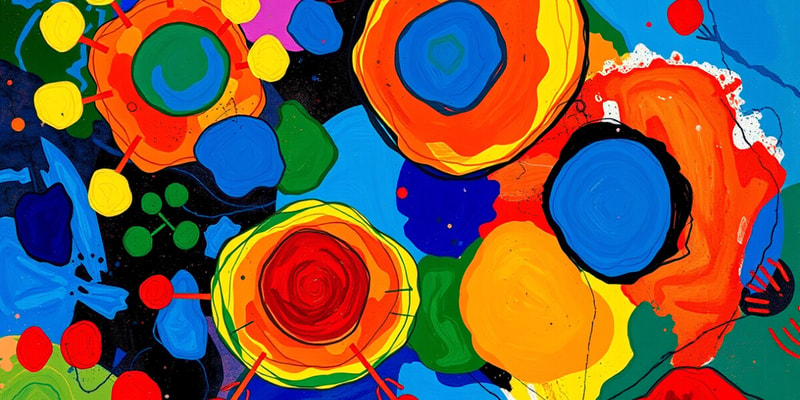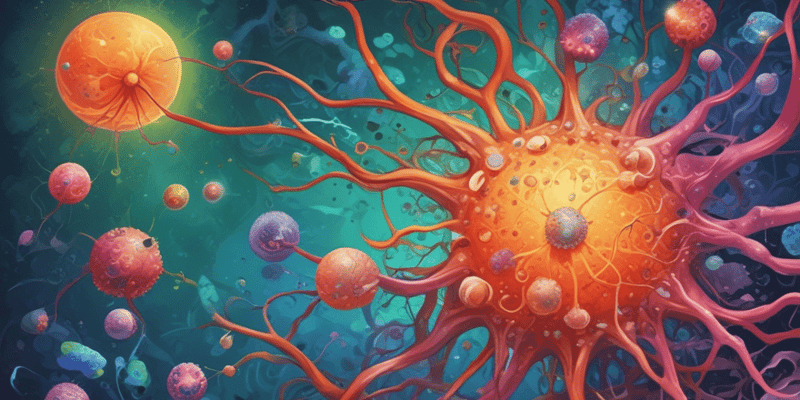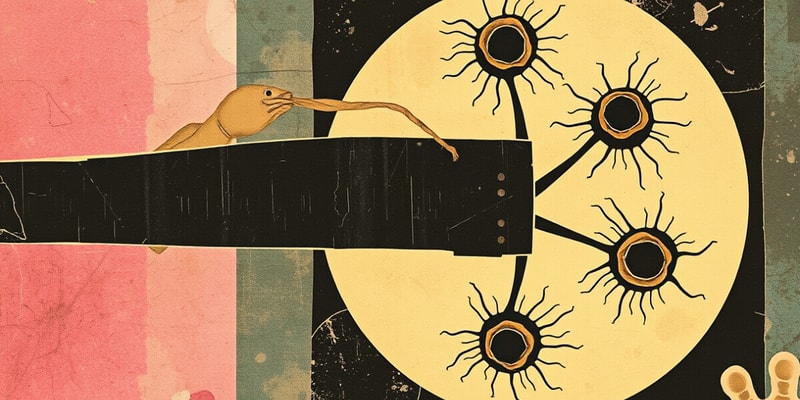Questions and Answers
What is the role of the enzyme activation-induced deaminase (AID) in B cell differentiation?
How long do most mature B cells survive in the lymphatic system without encountering an antigen?
What is the lifespan of plasma cells that have encountered their antigen and developed from B cells?
Which statement is true regarding the differentiation of B cells into plasma cells?
Signup and view all the answers
What allows a fully differentiated plasma cell to have surface-bound IgG despite producing antibodies?
Signup and view all the answers
What is the primary role of B cell receptors in the adaptive immune response?
Signup and view all the answers
Which of the following correctly describes the structure of a B cell receptor?
Signup and view all the answers
What is the significance of the Fab region in a B cell receptor?
Signup and view all the answers
During the development of a B cell, which heavy chain is initially expressed?
Signup and view all the answers
How many identical antigen binding sites does each B cell receptor have?
Signup and view all the answers
What structural component links the heavy and light chains of a B cell receptor?
Signup and view all the answers
What happens to the B cell receptor as the cell transforms into a plasma cell?
Signup and view all the answers
What are the five major types of heavy chains associated with immunoglobulin isotypes?
Signup and view all the answers
What is the result of alternative splicing in mature B cells?
Signup and view all the answers
Which structure do B cells migrate to after entering the lymph node?
Signup and view all the answers
What must occur for a B cell to become activated?
Signup and view all the answers
Which of the following molecules helps initiate B cell activation in conjunction with the B cell receptor?
Signup and view all the answers
Upon activation, what type of antibody does the B cell secrete initially?
Signup and view all the answers
How does isotype switching affect IgM production in B cells?
Signup and view all the answers
Which transcription factors are activated upon phosphorylation of the ITAMs in B cells?
Signup and view all the answers
What role do high endothelial venules (HEVs) play in the lymphatic system?
Signup and view all the answers
What specific amino acids are crucial within the ITAM for B cell activation?
Signup and view all the answers
What happens when CD40 on a B cell interacts with CD40L on an activated T cell?
Signup and view all the answers
What is the role of the immune receptor tyrosine-based activation motif (ITAM) in B cells?
Signup and view all the answers
Which cytokines promote a B cell's differentiation into an IgE secreting plasma cell?
Signup and view all the answers
Which process does NOT occur once a B cell is activated?
Signup and view all the answers
What is the consequence of C3d binding to CD21 on B cells?
Signup and view all the answers
Study Notes
Immune Response and Lymphocytes
- Immune response is highly specific for each invader via unique receptors on adaptive immune cells.
- Key players in adaptive immunity are lymphocytes: B cells and T cells.
Development and Structure of B Cells
- B cells develop in the bone marrow through VDJ rearrangement, creating a diverse set of B cell receptors (BCRs).
- B cell receptors function as antibodies with a transmembrane component, consisting of two heavy chains and two light chains.
- The fragment-antigen binding (Fab) region of the BCR binds to antigens, while the constant region (Fc) remains unchanged.
- Heavy chains are linked by disulfide bonds, and each BCR has two identical binding sites.
Isotypes and Alternative Splicing
- Five major classes of immunoglobulins defined by heavy chain types: IgM, IgD, IgG, IgA, and IgE.
- Initially, developing B cells express mu heavy chains, resulting in surface IgM.
- Alternative splicing allows simultaneous expression of IgM and IgD, characterizing mature but naive B cells.
Antigen Exploration and Activation
- Mature B cells travel through lymph nodes, searching for antigens and interacting with various immune cells.
- Entrance into lymph nodes can occur via afferent lymphatic vessels or high endothelial venules (HEVs).
- B cells migrate to the cortical region and can form primary lymphoid follicles, potentially leading to germinal center formation upon activation.
B Cell Activation Mechanisms
- B cells recognize diverse antigens, including peptides, carbohydrates, and lipids in their native forms.
- Antigen crosslinking of BCRs triggers activation through clustering of intracellular chains (Ig alpha, Ig Beta, CD19).
- Immune receptor tyrosine-based activation motifs (ITAMs) undergo phosphorylation by specific protein kinases (Blk, Fyn, Lyn).
Cytokines and Proliferation
- Activated B cells express key transcription factors like NFkappaB and NFAT, leading to cytokine production (IL-1, IL-2, IL-6, TNF alpha) and upregulation of anti-apoptotic markers (Bcl-2).
- CD21 (CR2) binds to complement fragment C3d, facilitating B cell activation alongside BCR signaling.
Plasma Cell Differentiation and Isotype Switching
- Activated B cells differentiate into plasma cells, primarily secreting IgM antibodies.
- Interaction with CD4+ T cells can induce class switching to produce other antibody isotypes, requiring DNA rearrangement.
Role of T Cells in B Cell Activation
- B cells present antigens on MHC class II to CD4+ T cells, which, upon activation, express CD40L.
- CD40-CD40L interaction prompts B cells to express cytokine receptors and respond to T cell cytokines for specific antibody production.
Life Cycle of B Cells and Plasma Cells
- Mature B cells have a typical lifespan of around 6 months in the lymphatic system without antigen stimulation.
- Plasma cells, which produce antibodies, survive roughly 6 weeks and do not divide.
- Continuous maturation from bone marrow replenishes B cells to ensure adequate immune response even after the plasma cells die.
Studying That Suits You
Use AI to generate personalized quizzes and flashcards to suit your learning preferences.
Description
This quiz explores the specifics of the adaptive immune response, focusing on the roles of B and T lymphocytes. Learn about VDJ rearrangement and how these cells identify pathogens through unique receptors. Test your understanding of key concepts in immunology.




